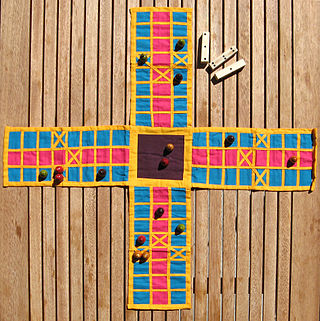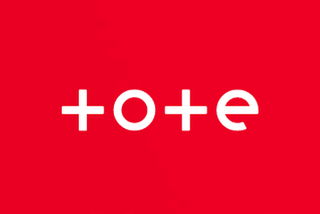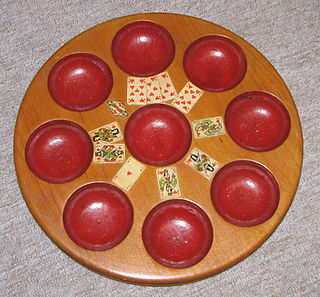
Gambling is the wagering of something of value on a random event with the intent of winning something else of value, where instances of strategy are discounted. Gambling thus requires three elements to be present: consideration, risk (chance), and a prize. The outcome of the wager is often immediate, such as a single roll of dice, a spin of a roulette wheel, or a horse crossing the finish line, but longer time frames are also common, allowing wagers on the outcome of a future sports contest or even an entire sports season.

Ludo is a strategy board game for two to four players, in which the players race their four tokens from start to finish according to the rolls of a single die. Like other cross and circle games, Ludo is derived from the Indian game Pachisi. The game and its variations are popular in many countries and under various names.

Roulette is a casino game which was likely developed from the Italian game Biribi. In the game, a player may choose to place a bet on a single number, various groupings of numbers, the color red or black, whether the number is odd or even, or if the number is high or low.

Pétanque is a sport that falls into the category of boules sports. In these sports, players or teams play their boules/balls towards a target ball. In pétanque the objective is to score points by having boules closer to the target than the opponent after all boules have been thrown. This is achieved by throwing or rolling boules closer to the small target ball, officially called a jack, or by hitting the opponents' boules away from the target, while standing inside a circle with both feet on the ground. The game is normally and best played on hard dirt or gravel. It can be played in public areas in parks or in dedicated facilities called boulodromes.

Pachisi is a cross and circle board game that originated in Ancient India. It is described in the ancient text Mahabharata under the name of "Pasha". It is played on a board shaped like a symmetrical cross. A player's pieces move around the board based upon a throw of six or seven cowrie shells, with the number of shells resting with the aperture upward indicating the number of spaces to move.

Lingo is an American television game show with multiple international adaptations. Contestants compete to decode five-letter words given the first letter, similarly to Jotto, with each correctly guessed word earning number draws to attempt filling in a Bingo card.

Guillaume Coustou the Elder was a French sculptor of the Baroque and Louis XIV style. He was a royal sculptor for Louis XIV and Louis XV and became Director of the Royal Academy of Painting and Sculpture in 1735. He is best known for his monumental statues of horses made for the Chateau of Marly, whose replicas now stand in the Place de la Concorde in Paris.

Trente et Quarante, also called Rouge et Noir, is a 17th-century gambling card game of French origin played with cards and a special table. It is rarely found in US casinos, but still very popular in Continental European casinos, especially in France, Italy, and Monaco. It is a simple game that usually gives the players a very good expected return of more than 98%.

A teetotum is a form of spinning top most commonly used for gambling games. It has a polygonal body marked with letters or numbers, which indicate the result of each spin. Usage goes back to ancient Greeks and Romans, with the popular put and take gambling version going back to medieval times. A perinola is a six-sided top with similar gameplay most commonly used in Latin America.

Knucklebones, also known as scatter jacks, snobs, astragaloi, tali, dibs, fivestones, jacks, jackstones, or jinks, among many other names, is a game of dexterity played with a number of small objects that are thrown up, caught, and manipulated in various manners. It is ancient in origin and is found in various cultures worldwide.

Jeu des petits chevaux is a French cross and circle game, closely related to ludo. It consists of moving several pawns to the home reserved for their color. Each player will receive between 1 and 3 horses in general. The first player to reach the last triangular square wins the game.

Kelly pool is a pool game played on a standard pool table using a standard set of 16 pool balls. Gameplay involves players each drawing one of 16 numbered markers called peas or pills at random from a shake bottle, which assigns to them the correspondingly numbered pool ball, kept secret from their opponents, but which they must pocket to win the game. Kelly pool is a rotation game, which means that players must contact the lowest numbered object ball on each shot first until the opportunity to pocket their own is presented. If a player draws the number 16, this player is assigned the cue ball. In order to pocket the cue ball, the player must contact the lowest ball first and in the same shot, pocket the cue ball. However, the game is commonly played by removing the pea numbered 16 and playing with the basic 15 numbered balls and corresponding peas. Two rule variants are set forth under rules promulgated by the Billiard Congress of America (BCA). In the simpler form, the object of play starts and ends with the goal of pocketing one's secret ball. In the second, in addition to the goal of pocketing one's secret ball, points are scored in various ways. In the instance where pills are unavailable, a cloth may be used to cover the balls, which are then chosen blindly, recorded, and replaced for play.

The Tote is a British gambling company founded in 1928. It is one of the world’s largest pool betting operators. Its product offering also includes sports betting and online casino. Business operations are led from its headquarters in Wigan.

Gilet, also Gile, Gillet, is a 16th-century Italian gambling card game that probably predates the game of Primero. Rabelais, in 1534, gives it pride of place in his list of games played by Gargantua, and Cardano, in 1564, describes it as Geleus, from the word Geleo, meaning "I have it".

Pope Joan or Pope, a once popular Victorian family game, is an 18th-century English round game of cards for three to eight players derived from the French game of Matrimony and Comete and ancestor to Spinado and the less elaborate Newmarket. The game is related to the German Poch and French Nain Jaune.

Tippen, also known as Dreiblatt, Dreikart, Drei Karten, Dreekort, Kleinpréférence or Labet, is an historical German 3-card, plain-trick game which was popular as a gambling game for three or more players. The Danish version of the game was known as Trekort and more elaborate Swedish variants include Knack and Köpknack. It appears to be related to the English game of Three-Card Loo. It was banned as a gambling game in some places.

Poch, Pochen or Pochspiel is a very old card game that is considered one of the forerunners of poker, a game that developed in America in the 19th century. An etymological relationship between the game names is also assumed. Games related to Poch are the French Glic and Nain Jaune and the English Pope Joan. Other forerunners of poker and possible relatives of the game are the English game, Brag, from the 16th century and the French Brelan and Belle, Flux et Trente-et-Un. Poch is recorded as early as 1441 in Strasbourg. In north Germany it was called by the Low German name of Puchen or Puchspill, and the board was a Puchbrett.

Mistigri, historically Pamphile, is an old, French, trick-taking card game for three or four players that has elements reminiscent of poker. It is a member of the Rams family of games and, although it is a gambling game, often played for small stakes, it is also suitable as a party game or as a family game with children from the age of 12 upwards.

Boule is a gambling game, similar to roulette, that dates back to the popular 19th-century game of Petits Chevaux.

The game of Nain Jaune or Yellow Dwarf, also formerly called Lindor, is an "attractive and unique traditional French card game" using a board comprising five compartments or boxes. It is a reasoned game of chance because it combines the hazards of card distribution with the strategy of building suits. Nain Jaune, which is considered a classic French game, is named after the seven of diamonds, which is depicted as a yellow dwarf in the centre of the game board.



















